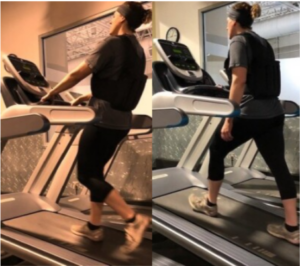Whether uphill outside or on a treadmill incline, being overweight need not be an obstacle to getting fitter & leaner.
You can speed your progress with a technique called high intensity interval training—or its derivative, interval training.
I see overweight people walking uphill on long hiking trails, and they do a pretty good job of it.
Oddly, when I see overweight people using a treadmill incline, nearly 100 percent of them are holding on.
This will have zero carry-over to walking hills outside, and it will do very little for achieving their fitness and weight loss goals.
Tips for Walking Uphill Outside for Overweight Adults
• Make sure you’re broken into your athletic footwear; wear the shoes on neighborhood walks, for instance, before you take off on the trails, to screen for any blister development.
• Bring with you for the trail a bottle of water.
• Do not use walking sticks, ski poles or Nordic poles. These act as assistive devices and subtract work from your core, spine, hips, legs and feet.
• If you’re completely untrained for uphill walking, proceed as a thinner person would: Don’t try to do too much at once. Don’t try to tackle unstable terrain.
• Stay local, meaning, loop around hiking trails that are close to the trailhead rather than venturing further and further out.
Otherwise you may suddenly realize how fatigued you are—when you’re a mile from the trailhead.
Tips for Walking a Treadmill Incline for Overweight Adults
• Do not hold on. This is the biggest issue. I just can’t say it enough: Holding on unteaches your body ambulatory efficiency.

It’s common sense, not just science: Which walk looks more realistic for a hill?
• Holding on burns 20 percent fewer calories than walking hands-free. The calorie readout is not reliable; it’s triggered by the motor speed and incline setting, not the person on the machine.
• Focus on deep steady breathing and moving your arms in synch with your lower body.
Interval Training
The work interval is a brief period in which you’re walking faster than what’s comfortable, getting you winded.
The work interval lasts 10 seconds to a minute or more. If you’re going beyond several minutes, though, this won’t be as effective as if you moved faster for a briefer period.
Moving your absolute fastest over a 10 to 30 second period — and I mean your FASTEST, to the point where you’re really huffing and puffing at the end — is an intense version of interval training.
You’re so out of breath that it’s very uncomfortable to speak at the end of that 10 or 30 seconds.
With non-intense interval training, your movement is slower, allowing you to go beyond 30 seconds, but you can stop at 30 seconds, or even 15 — it’s just that at the end of this work interval, you’re not huffing and puffing, but you are still quite winded and feel like you really need to rest.
The rest interval should be one to several minutes of easy paced walking. If you’re on a hill outside, adjust this easy pace to correlate to the steepness.
So if the hill is really steep, go really, really slow, but do not stop. You may want to do switch-backs (walking diagonally back and forth as you slowly ascend) if there’s room on the trail.
With a treadmill, lower the incline and speed, or just the speed, whatever it takes so that the rest interval recovers you.
Final Tip for Uphill Walking for Overweight Men & Woman
Don’t right away jump into high inclines, as this will cause sore calves the next day.
In fact, your calves will probably burn right then and there. Always warm up.
Slow down and/or move to a milder incline or lower the treadmill grade, and remember, if you’re using a treadmill, do not hold on.
Overweight people who want to get fitter walking uphill can also join a hiking group.
 Lorra Garrick is a former personal trainer certified through the American Council on Exercise. At Bally Total Fitness she trained women and men of all ages for fat loss, muscle building, fitness and improved health.
Lorra Garrick is a former personal trainer certified through the American Council on Exercise. At Bally Total Fitness she trained women and men of all ages for fat loss, muscle building, fitness and improved health.
.










































